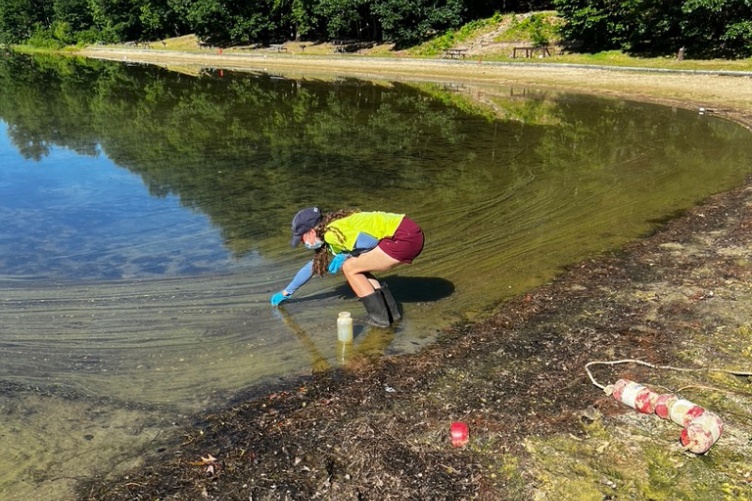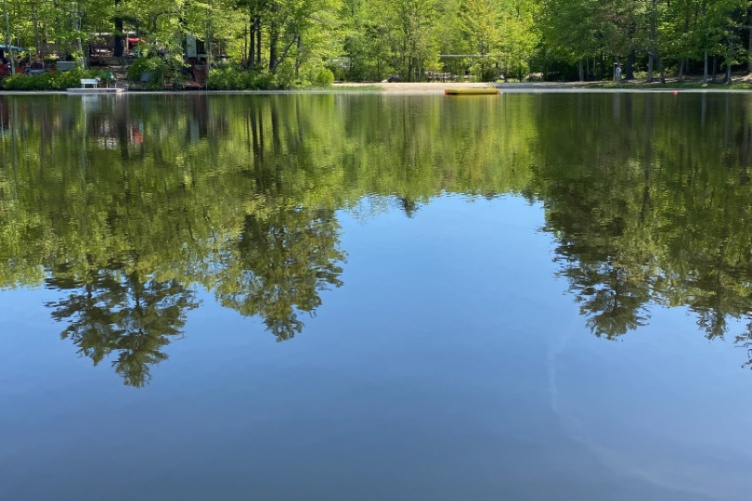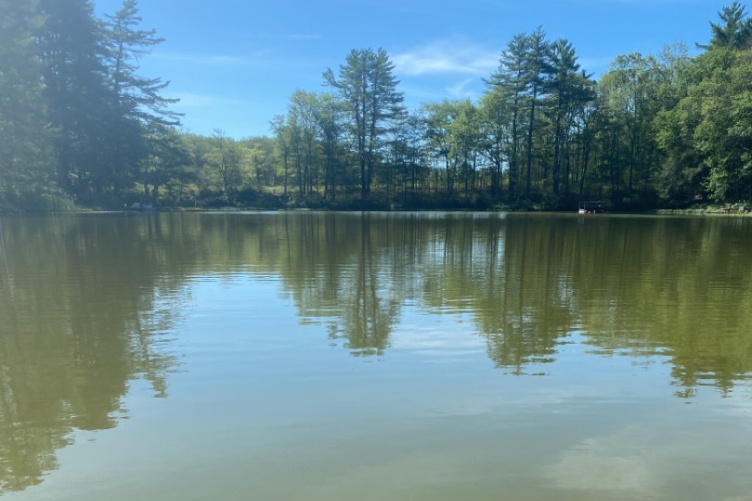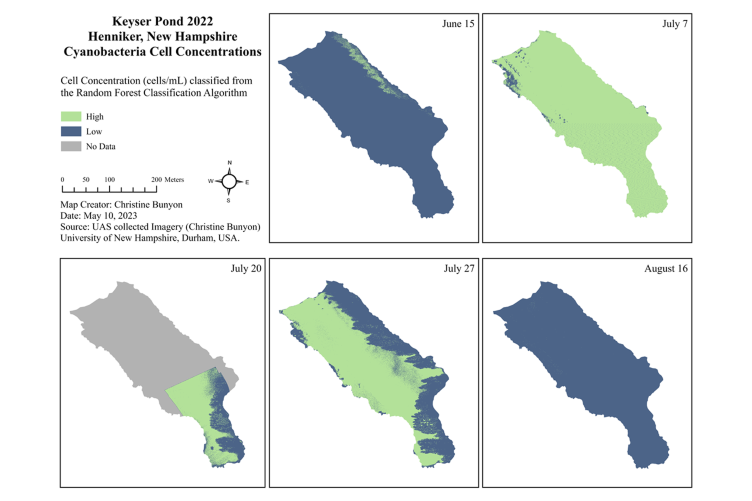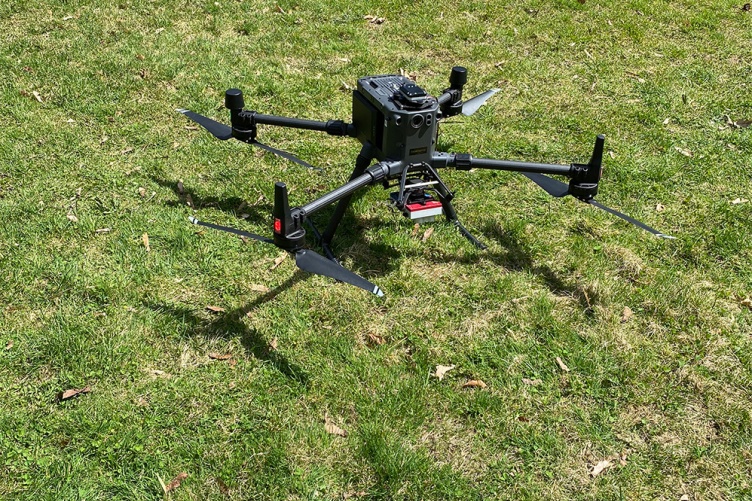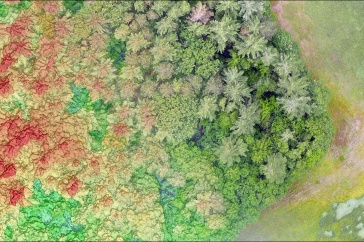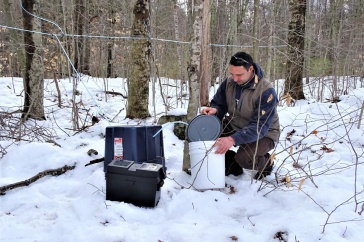Key Finding:
Using a multispectral sensor on an unpiloted aerial system (UAS) proved over 90 percent effective in detecting cyanobacteria blooms—also known as harmful algal blooms (HABs)—in New Hampshire waterbodies, offering a safer and faster alternative to traditional water sampling methods.
Key Terms:
Cyanobacteria: A group of bacteria species known by the common name blue-green algae. Although not considered algae, cyanobacteria possess algal characteristics, such as possessing chlorophyll (allowing them to photosynthesize), forming visible colonies on the water and being either unicellular or multicellular. Learn where cyanobacteria are found.
One of the first organisms known to produce oxygen on Earth, cyanobacteria played an important role in oxidizing Earth’s first atmosphere and allowing for the growth of new life. Cyanobacteria are found in nearly every terrestrial and aquatic environment on Earth. They differ from other bacteria in that they contain chlorophyll and phycobilin pigments, such as phycocyanin, resulting in their blue-green color and photosynthetic abilities—among other characteristics.
Multispectral sensor: Collects information about the reflected light from objects in the environment, allowing for a comparison with neighboring objects to identify significant distinctions between them.
10-band multispectral sensor: Measures reflected light energy within 10 different wavelengths or bands of the electromagnetic spectrum. Multispectral sensors usually have between 3 and 10 band measurements in each pixel of the images they produce.
What Causes Cyanobacteria Blooms?
Harmful algal blooms (HABs) occur when cyanobacteria species undergo rapid and excessive growth in water bodies. These blooms are fueled by factors like nutrient enrichment from human activities, warm water temperatures, and ample sunlight for photosynthesis. When these conditions align, harmful algae can multiply rapidly, forming dense and visible blooms that may produce toxins harmful to aquatic life and human health. Learn how to check for HABs in New Hampshire.
Cyanobacteria blooms both produce and consume large amounts of dissolved oxygen, creating areas of low dissolved oxygen or anoxia in which other aquatic organisms, including fish, struggle to survive. Blooms can also block sunlight to aquatic plants beneath. Some cyanobacteria species have the capability to produce toxins that pose health risks to humans and animals alike. These risks include gastrointestinal problems, skin irritation, respiratory difficulties, and in severe cases, even neurological damage or death.
The best way to check if a New Hampshire waterbody has a cyanobacteria advisory is to use the New Hampshire Department of Environmental Services (NHDES) interactive “Healthy Swimmer Mapper” tool. NHDES also encourages people to report cyanobacteria blooms using their Bloom Report Form.
Traditional Methods of Monitoring for Cyanobacteria Blooms
The New Hampshire Department of Environmental Services (NHDES) actively monitors cyanobacteria blooms in waterbodies across the state. As of July 20, 2023, NHDES had issued warnings or advisories for 27 lakes and ponds, advising the public to avoid these waterbodies. However, the conventional method of monitoring—and, for active blooms, checking to determine if cell concentrations exceed the state threshold of 70,000 cells per milliliter to trigger an advisory—involves time-consuming water sampling and testing, which may also expose environmental specialists to potential risks.
Billions of years ago, cyanobacteria were crucial to some of Earth’s first lifeforms that produced oxygen and helped form the planet’s atmosphere. More recently, a changing climate has led to increases in toxic blue-green algae blooms of cyanobacteria in New Hampshire lakes—popular summer getaways for Granite Staters and visitors, and important economic drivers for the state. Traditional monitoring of these blooms involves time-consuming water sampling and testing that can also expose environmental specialists to potential health risks. To overcome these challenges, NH Agricultural Experiment Station scientist Russell Congalton and his team at the UNH Basic and Applied Spatial Analysis Lab have developed a promising alternative for identifying aquatic cyanobacteria blooms—using unpiloted aerial systems (UAS), or drones.
Congalton's research team demonstrated that by equipping UAS devices with special sensors, flying them over bodies of water, and collecting and analyzing images of the waterbodies, this enabled the researchers to accurately determine cyanobacteria concentrations based on spectral response. Congalton, a professor at the UNH College of Life Sciences and Agriculture, along with lead author Christine Bunyon ’17 ’23G; postdoctoral researcher Benjamin Fraser ’15 ’17G ’21G; and UNH Extension specialist Amanda McQuaid, published their findings in Remote Sensing.
Cyanobacteria Testing: Lab Vs. UAS
"The ‘traditional’ method of testing for cyanobacteria took so much longer because each sample had to be collected and processed individually,” said Bunyon, who works as a project scientist and geographic information system specialist for FB Environmental Associates. “This meant that one at a time, I had to paddle to a site, collect field measurements and a sample, then bring those samples back to a lab and look at them under a microscope—one by one—to physically count the number of cyanobacteria cells.”
To assess and validate the remote sensing technology, Bunyon and Fraser spend May through September 2022 conducting tests using UAS devices in six waterbodies in southern New Hampshire: Silver Lake (Hollis, N.H.) and French, Greenwood, Keyser, Showell, and Tucker ponds. The data collection process involved an aerial scan of the lake, performed in a lateral grid pattern, followed by canoeing to selected sample locations to gather water samples.
Bunyon then tested the samples for cyanobacteria at the UNH Water Quality Analysis Laboratory, which involved analyzing over 180 samples for chlorophyll-a—each sample taking over two days to analyze. Comparatively, the collection and processing of the UAS imagery took significantly less time—about 4.5 times faster—than the traditional water sampling method.
The study also revealed a correlation between cyanobacteria cell concentration and concentrations of chlorophyll-a and phycocyanin—the latter being a pigment responsible for the blue-green algae's color. This correlation allowed for the use of spectral data to identify cyanobacteria, chlorophyll-a and phycocyanin concentrations on the water’s surface, aiding in determining potential harm levels.
"Depending on the size of the lake, it might take as little as 10-15 minutes to fly the entire lake. Then using the collected multispectral imagery, we could show state specialists where the problem areas are pretty quickly, and at a very fine scale, which both increases our understanding of these [harmful algal blooms] and reduces our sampling costs,” said Fraser.
A pie chart providing an approximate comparison of the amount of time each tasks took to complete. Blue sections represent those associated with the collection and processing of water quality parameters. Grayscale sections represent those associated with the collection and processing of UAS parameters. Traditional water quality tasks took roughly 310 hours to complete while UAS tasks took roughly 65 hours to complete. Graphic courtesy of Christine Bunyon.
Cyanobacteria Testing: A Growing Need
McQuaid, who previously served as the NH Department of Environmental Services (NHDES) Beach Inspection Program Coordinator, emphasized the record number of advisories and alerts issued in recent years. In 2022, the NHDES commissioned the Cyanobacterial Plan Advisory Committee to prepare a statewide plan for addressing cyanobacteria, which will be submitted in November. And while more research is needed to overcome limitations such as capturing imagery from the center of larger bodies of water, NH Agricultural Experiment Station research shows that UAS technology offers an important tool for finding and identifying blooms in lakes and ponds.
“This was the first study of this kind done within New Hampshire and, when compared to similar studies done elsewhere around the U.S. and world, it examined far more bodies of water to provide us more data to support our findings,” said Congalton. “Christine and Ben flew a total of 22 times and collected and processed over 180 water samples, which was a pretty enormous feat to achieve in just a few months.”
This material is based on work supported by the NH Agricultural Experiment Station through joint funding from the USDA National Institute of Food and Agriculture (under McIntire-Stennis award number 1026105) and the state of New Hampshire.
This work is co-authored by Christine Bunyon, Benjamin Fraser, Amanda McQuaid, and Russell Congalton.
You can read the published article, Using Imagery Collected by an Unmanned Aerial System to Monitor Cyanobacteria in New Hampshire, USA, Lakes, in Remote Sensing.
-
Written By:
Nicholas Gosling '06 | COLSA/NH Agricultural Experiment Station | nicholas.gosling@unh.edu

















































